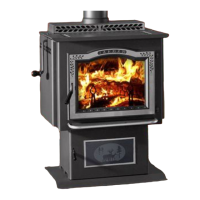20
When wood is burned slowly, it produces tar
and other organic vapors, as well as soot, which
combine with expelled moisture to form creosote.
The creosote vapors condense in the relatively
cool chimney ue (associated with a slow burning
re). As a result, creosote accumulates on the ue
lining. When ignited, this creosote can result in an
extremely hot re.
The FireDome on the TL300 cuts creosote to
almost nothing
The chimney should be inspected at least once
every two months during the heating season to see if
any creosote build-up has occurred. Checking your
chimney and chimney connector more frequently,
especially while you are getting used to your stove,
is recommended. To inspect this system, let the
stove cool. Using a ashlight and mirror, check the
interior of the chimney connector, and the chimney
itself. If a signicant layer of creosote or soot has
accumulated (1/8" or 3 mm) it should be removed
to reduce the risk of a chimney re.
To clean deposits from the surface of the
connector, use a stiff wire brush after dismantling
the connector assembly. To clean the chimney,
use a specially designed brush sized to t your
particular flue opening, or call an established
chimney cleaning service.
At the end of the heating season, perform a
thorough examination of your chimney system, and
have it repaired if necessary.
After the stove has been in operation for awhile,
the damper gasket may compress and allow the
damper handle to move from the open to the closed
position without the added ramp tension needed
to keep the damper held in the closed position.
• After the stove has cooled off, remove the stove
pipe from the stove collar and close the damper.
• Using a ashlight, look into the collar. About
midpoint of the damper plate on the backside you
will see the adjustment bolt for the ramp tension.
(See gure on right.)
• You will need (2) 7/16 " wrenches. Use one to hold
the bolt still while using the other to loosen the nut.
• Turn the bolt inward (clockwise facing the head)
approximately 1/4 turn and retighten the locknut.
• Now open and close the damper to check for
proper tension on the damper lever while moving
into the closed direction.
• If the tension is incorrect, readjust the bolt.
Gaskets are used at strategic positions when
building the Harman TL300 for controlling the
path that incoming and outgoing air and gases
take through the stove. You must check these
gaskets from time to time and replace them when
necessary. The gaskets are made of berglass
of different sizes (obtainable from your Harman
dealer) and some are xed in place with a high
temperature stove gasket cement. To change a
gasket, rst remove the worn berglass and clean
the area with a wire brush. Also clean any other
surfaces that come into contact with the gasket.
Place a small bead of cement in the area under the
gasket if required, then press new gasket material
into the channel; do not overlap the ends. Seat the
gasket rmly by applying pressure when possible;
for example, after changing the door gasket, close
the door. Allow the cement to dry before using
your stove.
Gaskets are located:
• On the doors to provide airtight closure.
• Between the damper and the damper frame.
• Rear cover
• Rear housing
Loosen nut
Turn bolt inward 1/4
turn.

